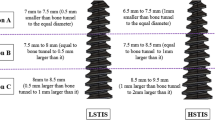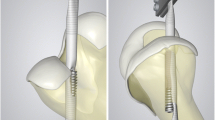Abstract
Postoperative tunnel enlargement has been frequently reported after anterior cruciate ligament (ACL) reconstruction. Interference screw, as a surgical implant in ACL reconstruction, may influence natural loading transmission and contribute to tunnel enlargement. The aims of this study are (1) to quantify the alteration of strain energy den sity (SED) distribution after the anatomic single-bundle ACL reconstruction; and (2) to characterize the influence of screw length and diameter on the degree of the SED alteration. A validated finite element model of human knee joint was used. The screw length ranging from 20 to 30mm with screw diameter ranging from 7 to 9 mm were investigated. In the post-operative knee, the SED increased steeply at the extra-articular tunnel aperture under compressive and complex loadings, whereas the SED decreased beneath the screw shaft and nearby the intra-articular tunnel aperture. Increasing the screw length could lower the SED deprivation in the proximal part of the bone tunnel; whereas increasing either screw length or diameter could aggravate the SED deprivation in the distal part of the bone tunnel. Decreasing the elastic modulus of the screw could lower the bone SED deprivation around the screw. In consideration of both graft stability and SED alteration, a biodegradable interference screw with a long length is recommended, which could provide a beneficial mechanical environment at the distal part of the tunnel, and meanwhile decrease the bone-graft motion and synovial fluid propagation at the proximal part of the tunnel. These findings together with the clinical and histological factors could help to improve surgical outcome, and serve as a preliminary knowledge for the following study of biodegradable interference screw.

Similar content being viewed by others
References
Levine, J.W., Kiapour, A.M., Quatman, C.E., et al.: Clinically relevant injury patterns after an anterior cruciate ligament injury provide insight into injury mechanisms. The American Journal of Sports Medicine 41, 385–395 (2013)
Li, G., Suggs, J., Gill, T.: The effect of anterior cruciate ligament injury on knee joint function under a simulated muscle load: A three-dimensional computational simulation. Annals of Biomedical Engineering 30, 713–720 (2002)
Louboutin, H., Debarge, R., Richou, J., et al.: Osteoarthritis in patients with anterior cruciate ligament rupture: A review of risk factors. The Knee 16, 239–244 (2009)
Oiestad, B.E., Holm, I., Aune, A.K., et al.: Knee function and prevalence of knee osteoarthritis after anterior cruciate ligament reconstruction: A prospective study with 10 to 15 years of follow-up. The American Journal of Sports Medicine 38, 2201–2210 (2010)
Iorio, R., Vadala, A., Argento, G., et al.: Bone tunnel enlargement after ACL reconstruction using autologous hamstring tendons: a CT study. International Orthopaedics 31, 49–55 (2007)
Giron, F., Aglietti, P., Cuomo, P., et al.: Anterior cruciate ligament reconstruction with double-looped semitendinosus and gracilis tendon graft directly fixed to cortical bone: 5-year results. Knee Surgery, Sports Traumatology, Arthroscopy 13, 81–91 (2005)
Peyrache, M.D., Djian, P., Christel, P., et al.: Tibial tunnel enlargement after anterior cruciate ligament reconstruction by autogenous bone-patellar tendon-bone graft. Knee Surgery, Sports Traumatology, Arthroscopy 4, 2–8 (1996)
Simonian, P.T., Monson, J.T., Larson, R.V.: Biodegradable interference screw augmentation reduces tunnel expansion after ACL reconstruction. The American Journal of Knee Surgery 14, 104–108 (2001)
Siebold, R.: Observations on bone tunnel enlargement after double-bundle anterior cruciate ligament reconstruction. Arthroscopy 23, 291–298 (2007)
Bugbee, W.D., Culpepper, W.J., Engh, Jr. C.A., et al.: Longterm clinical consequences of stress-shielding after total hip arthroplasty without cement. The Journal of Bone and Joint Surgery 79, 1007–1012 (1997)
Tissakht, M., Ahmed, A.M., Chan, K.C.: Calculated stress-shielding in the distal femur after total knee replacement corresponds to the reported location of bone loss. Journal of Orthopaedic Research 14, 778–785 (1996)
Bach Jr., B.R.: Special report: Observations on interference screw morphologies. Arthroscopy 16, E10 (2000)
Abdullah, A.H., Othman, M.F., Rashid, H., et al.: Effects of interference screw lengths on the primary stability of anterior cruciate ligament reconstruction. Advanced Science Letters 19, 873–876 (2013)
Harvey, A.R., Thomas, N.P., Amis, A.A.: The effect of screw length and position on fixation of four-stranded hamstring grafts for anterior cruciate ligament reconstruction. The Knee 10, 97–102 (2003)
Namkoong, S., Heywood, C.S., Bravman, J.T., et al.: The effect of interference screw diameter on soft tissue graft fixation. Bulletin (Hospital for Joint Diseases (New York, N.Y.)) 63, 153–155 (2006)
Herrera, A., Martinez, F., Iglesias, D., et al.: Fixation strength of biocomposite wedge interference screw in ACL reconstruction: effect of screw length and tunnel/screw ratio. A controlled laboratory study. BioMed Central Musculoskeletal Disorders 11, 139 (2010)
Lin, C.L., Lin, Y.H., Chang, S.H.: Multi-factorial analysis of variables influencing the bone loss of an implant placed in the maxilla: Prediction using FEA and SED bone remodeling algorithm. Journal of Biomechanics 43, 644–651 (2010)
Mellal, A., Wiskott, H.W., Botsis, J., et al.: Stimulating effect of implant loading on surrounding bone: Comparison of three numerical models and validation by in vivo data. Clinical Oral Implants Research 15, 239–248 (2004)
Yao, J., Wen, C., Cheung, J., et al.: Deterioration of stress distribution due to tunnel creation in single-bundle and doublebundle anterior cruciate ligament reconstructions. Annals of Biomedical Engineering 40, 1554–1567 (2012)
Yao, J., Snibbe, J., Maloney, M., et al.: Stresses and strains in the medial meniscus of an ACL deficient knee under anterior loading: a finite element analysis with image-based experimental validation. Journal of Biomechanical Engineering 128, 135–141 (2006)
Blankevoort, L., Kuiper, J.H., Huiskes, R., et al.: Articular contact in a three-dimensional model of the knee. Journal of Biomechanics 24, 1019–1031 (1991)
Taylor, M., Tanner, K.E., Freeman, M.A.: Finite element analysis of the implanted proximal tibia: A relationship between the initial cancellous bone stresses and implant migration. Journal of Biomechanics 31, 303–310 (1998)
Fukubayashi, T., Kurosawa, H.: The contact area and pressure distribution pattern of the knee: A study of normal and osteoarthrotic knee joints. Acta Orthopaedica Scandinavica 51, 871–879 (1980)
Lee, Y.T., Peters, M., Welsch, G.: Elastic moduli and tensile and physical properties of heat-treated and quenched powder metallurgical Ti-6Al-4V alloy. Metallurgical and Materials Transactions A 22, 709–714 (1991)
Kutzner, I., Heinlein, B., Graichen, F., et al.: Loading of the knee joint during activities of daily living measured in vivo in five subjects. Journal of Biomechanics 43, 2164–2173 (2010)
Wilson, T.C., Kantaras, A., Atay, A., et al.: Tunnel enlargement after anterior cruciate ligament surgery. The American Journal of Sports Medicine 32, 543–549 (2004)
van Eck, C.F., Lesniak, B.P., Schreiber, V.M., et al.: Anatomic single- and double-bundle anterior cruciate ligament reconstruction flowchart. Arthroscopy 26, 258–268 (2010)
Harvey, A., Thomas, N.P., Amis, A.A.: Fixation of the graft in reconstruction of the anterior cruciate ligament. The Journal of Bone and Joint Surgery. British Volume 87, 593–603 (2005)
Macdonald, P., Arneja, S.: Biodegradable screw presents as a loose intra-articular body after anterior cruciate ligament reconstruction. Arthroscopy 19, E22–E24 (2003)
Hall, M.P., Hergan, D.M., Sherman, O.H.: Early fracture of a bioabsorbable tibial interference screw after ACL reconstruction with subsequent chondral injury. Orthopedics 32, 208 (2009)
Author information
Authors and Affiliations
Corresponding author
Additional information
The preject was supported by the National Science & Technology Pillar Program of China (2012BAI18B07 and 2012BAI22B02), the National Natural Science Foundation of China (10925208 and 11120101001), and the National Key Lab of Virtual Reality Technology.
These authors contribute equally to the article.
Rights and permissions
About this article
Cite this article
Yao, J., Kuang, GM., Wong, D.WC. et al. Influence of screw length and diameter on tibial strain energy density distribution after anterior cruciate ligament reconstruction. Acta Mech Sin 30, 241–249 (2014). https://doi.org/10.1007/s10409-014-0027-8
Received:
Revised:
Accepted:
Published:
Issue Date:
DOI: https://doi.org/10.1007/s10409-014-0027-8




